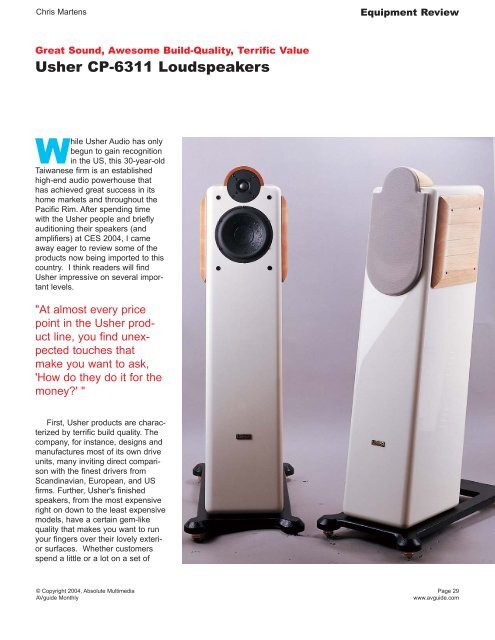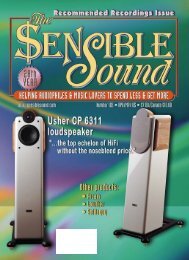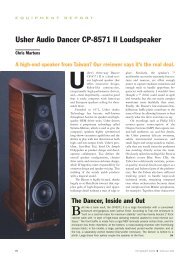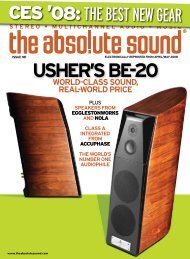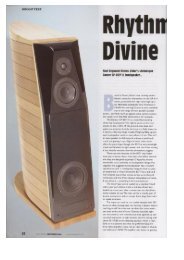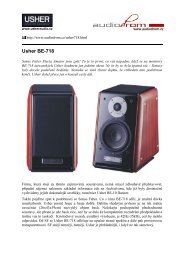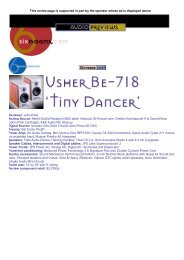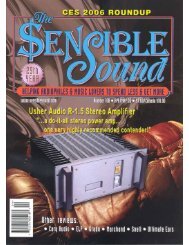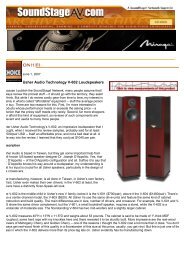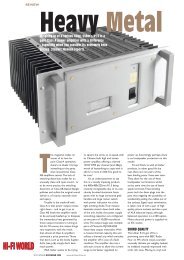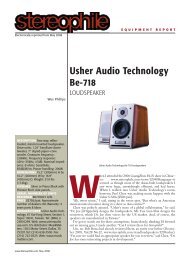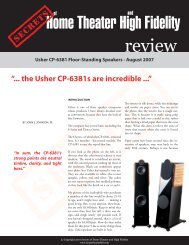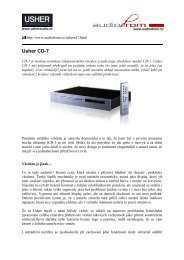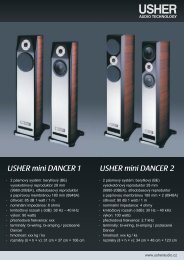Usher CP-6311 Loudspeakers - Usher Audio
Usher CP-6311 Loudspeakers - Usher Audio
Usher CP-6311 Loudspeakers - Usher Audio
- No tags were found...
Create successful ePaper yourself
Turn your PDF publications into a flip-book with our unique Google optimized e-Paper software.
Chris MartensEquipment ReviewGreat Sound, Awesome Build-Quality, Terrific Value<strong>Usher</strong> <strong>CP</strong>-<strong>6311</strong> <strong>Loudspeakers</strong>While <strong>Usher</strong> <strong>Audio</strong> has onlybegun to gain recognitionin the US, this 30-year-oldTaiwanese firm is an establishedhigh-end audio powerhouse thathas achieved great success in itshome markets and throughout thePacific Rim. After spending timewith the <strong>Usher</strong> people and brieflyauditioning their speakers (andamplifiers) at CES 2004, I cameaway eager to review some of theproducts now being imported to thiscountry. I think readers will find<strong>Usher</strong> impressive on several importantlevels."At almost every pricepoint in the <strong>Usher</strong> productline, you find unexpectedtouches thatmake you want to ask,'How do they do it for themoney?' "First, <strong>Usher</strong> products are characterizedby terrific build quality. Thecompany, for instance, designs andmanufactures most of its own driveunits, many inviting direct comparisonwith the finest drivers fromScandinavian, European, and USfirms. Further, <strong>Usher</strong>'s finishedspeakers, from the most expensiveright on down to the least expensivemodels, have a certain gem-likequality that makes you want to runyour fingers over their lovely exteriorsurfaces. Whether customersspend a little or a lot on a set of© Copyright 2004, Absolute MultimediaAVguide MonthlyPage 29www.avguide.com
Equipment Review<strong>Usher</strong>s, they'll come away with the(accurate) impression that theirspeakers were built by craftspeoplewho cared about what they weredoing.Second, <strong>Usher</strong>'s engineeringefforts are guided by <strong>Usher</strong>'sPresident, Mr. Lien-Shui Tsai, andthe legendary Dr. Joseph D'Appolito(best known for the popular"midrange-tweeter-midrange" configurationfrequently associated withhis name), with the result that<strong>Usher</strong>'s speaker designs combinefresh, innovative thinking with carefuladaptation (and meticulous evolutionand refinement) of good ideasdrawn from a variety of successfulpast designs. Tsai and D'Appolitoplan new <strong>Usher</strong> models together,with Mr. Tsai handling driver selection,enclosure design and cosmetics,while Dr. D'Appolito takesresponsibility for crossover designand final voicing of the speaker. Youmay see hints of apparent SonusFaber and Thiel influences in many<strong>Usher</strong> models, but do not make themistake of thinking that <strong>Usher</strong>s arepale copies of European orAmerican speakers. Just a few minutesof listening will convince youthat <strong>Usher</strong>s are legitimate high-endloudspeakers in their own right—speakers that can stand on theirown merits in comparison to likepricedhigh-end products from justabout anyone.Finally, and this is the icing onthe cake, <strong>Usher</strong> is deeply committedto delivering value for money(what's not to like about that?). Atalmost every price point in its productline, you find unexpected touchesthat make you want to ask, "Howdo they do it for the money?" Inplanning this review, I asked<strong>Usher</strong>'s US distributor to select onemodel he felt best represented<strong>Usher</strong>'s "value for money" philosophy,and he unhesitatingly recommended<strong>Usher</strong>'s new $2100/pair<strong>CP</strong>-<strong>6311</strong> floorstanding models (well,actually there was some hesitationbecause <strong>Usher</strong>'s new entry-level5.1-channel surround speaker systemalso offers dynamite value, butwe'll save those little jewels for afuture review).The <strong>CP</strong>-<strong>6311</strong> is a relatively talltwo-way, time/phase-aligned, bassreflexspeaker that incorporatesseveral interesting design twists.Probably the first thing that catchesviewers' eyes is the enclosure,which looks like a radically sweptback,Salvador Daliesqueinterpretationof a traditional towertypespeaker (thebackward slope of theenclosure aligns theacoustic centers oftweeter and woofer).Because the towersare angled backwardsquite steeply, <strong>Usher</strong>provides large, boltoncast iron skeletalfloor-support framesthat offer plenty ofstability (the framescome with largeknurled, solid-brassfloor spikes). A 1"fabric dome, ferrofluiddamped tweeter(which looks somewhat like thefamiliar ScanSpeak Revelatortweeter, but is in fact an <strong>Usher</strong>-builtunit) is perched at the very top ofthe enclosure, braced against asemi-conical shaped solid hardwoodtweeter "nacelle" that flaresout behind the mounting flange.Below the tweeter resides an<strong>Usher</strong>-made 7" woofer with a carbon-fiberfilled paper cone (the unitbears passing resemblance to certainScanSpeak woofers that usesimilar cone construction). Both<strong>Usher</strong> drive units are optimized forvery low distortion at high soundpressure levels. The upper sidewallsof each enclosure are bracedwith sculptural hardwood reinforcementpanels (reminiscent of theside panels on some Sonus Fabermodels) that look great and addextra rigidity in those sections of thecabinet adjacent to the woofer. Thecabinet features a mirror-smoothlacquered finish (in black, silver, orwhite) that contrasts nicely with thesatin-textured hardwood side panelsand tweeter nacelle. Whereverpractical, cabinet edges haveradiused corners that help minimizediffraction. Finally, at the rear of theenclosure, we find the speaker'sducted port, dual binding posts thatfacilitate bi-wiring, and a chamberthat can be filled with high-densitydamping materials. Overall, the<strong>CP</strong>-<strong>6311</strong> is a well-executed packagethat's pleasing to the eye. Butis it equally pleasing to the ear? Letme tackle that question by sketchingfor you a handful of qualitiesthat define the <strong>CP</strong>-<strong>6311</strong>'s sound.Let's begin with tonal balance.The <strong>CP</strong>-<strong>6311</strong>'s balance is generallyneutral, but shaded ever so slightlytoward the darker end of the spectrum.Two factors contribute to thisoverall balance. First, there is noexcess brightness in <strong>Usher</strong>'s fabricdome tweeter; and second, thespeaker offers a prodigious amountof bass output in the mid-to-low 40Hz range (more than is typical for© Copyright 2004, Absolute MultimediaAVguide MonthlyPage 30www.avguide.com
Equipment Reviewspeakers this size). I consider thetweeter's smooth, unexaggeratedsound a very good thing, since Iregard excess brightness as not toodifferent from torture, and my reactionto it is typically, "Aieee!Somebody please make it stop."Thanks to <strong>Usher</strong>'s sweet tweeter, Ifound I could fully enjoy recordingsthat have sometimes sounded too"hot" or etched on speakers withupturned treble regions (e.g., DianaKrall's extremely close-miked LoveScenes [Impulse], an album thatcan be downright abrasive if itsupper midrange and treble detailsare not handled properly). Throughthe <strong>Usher</strong>s, the recorded detailsand textures of my favorite recordingsalways seemed well defined,but without the punishing brightness,overwrought transients, or"Soundstage depth andwidth are among the bestI've heard from a speakerof this type..."fatiguing glare you find in many"high-definition" tweeters.Depending on your listening environment,the <strong>CP</strong>-<strong>6311</strong>s' strong midto-lowbass output might also be ablessing, though in some roomsand on some recordings it couldalso be—if not exactly a "curse,"then a characteristic to be managedwith care. On many recordings, the<strong>Usher</strong>s' vigorous bass balancesounded nearly ideal, but on somerecordings imbued with extremelystrong bass content (e.g., HollyCole's Temptation [Metro Blue]), thelowest frequencies are occasionallypushed too far forward in the mix(this small deviation from accuracyis one some listeners might like,and many might find preferable tothe paucity of bass encountered insome high-end speakers).Fortunately, the <strong>CP</strong>-<strong>6311</strong>'s bass istaut and well defined, so that occasionalmoments of forwardnesscome across more as pleasing lowfrequencyrichness than as boominessor bloat. Interestingly, thespeaker's balance sounded progressivelymore neutral as volumelevels were raised (within reason, ofcourse).Another major aspect of the <strong>CP</strong>-<strong>6311</strong>'s sound has to do with theoverall resolution, focus, and texture.I really have to compliment<strong>Usher</strong> on the job it has done withthis speaker's tweeter and midwoofer.The tweeter, as I suggestedabove, pulls off the difficult trickof sounding at once smooth andhighly detailed and finely resolved—qualities reminiscent of the sound oflive music. The woofer, in turn,offers fast yet well-dampedresponse to sharp transients andbrief moments of dynamic emphasis,and it climbs right up to the topof its frequency range without thecongestion you might expect from adriver its size. In practice, thismeans the woofer gives the <strong>CP</strong>-<strong>6311</strong> an unexpectedly clear, supple,and responsive midrange (better,actually, than I've heard in severalmore costly three-way speaker systems).On Bela Fleck and EdgarMeyer's delightful Music for Two[Sony Classical], for example, the<strong>Usher</strong>s let me hear the smallestvariations in Meyer's bass bowingtechniques, and showed how Fleckregulates the intensity of each pickstroke to build tension in his banjosolos. What's most important, andreally quite uncanny, is the way the<strong>Usher</strong> tweeter and woofer manageto speak with a common voice.Part of this is due, I suspect, toD'Appolito's decision to go with atime/phase-aligned design ("…anacoustic, 4th-order, in-phaseLinkwitz alignment," says Dr.D'Appolito), but much has to do withthe exemplary behavior of both driversin the critical crossover region.In that region, the woofer andtweeter match each other almostunbelievably well—speed for speed,texture for texture, and smoothnessfor smoothness. More than mosttwo-speakers, this one encouragesyou to forget that you're hearingindividual drivers, redirecting yourattention to the overall sound of themusic.A third, and for me particularlyappealing, characteristic of the<strong>Usher</strong>s is their great imaging andsoundstaging. The <strong>CP</strong>-<strong>6311</strong>'s imagingis hands down better than thatof most two-way floorstanders;these speakers have no trouble creatingconvincing lateral images thatbreak from the surfaces of theenclosures to float freely in spaceabove and between the speakers.Soundstage depth and width, too,are among the best I've heard froma speaker of this type (though perhapsnot quite up to the almost eerilyholographic standard set byGallo's radical new NucleusReference III—which, in fairness,costs almost 25% more than the<strong>CP</strong>-<strong>6311</strong>s). Nevertheless, the<strong>Usher</strong>s offer excellent three-dimen-© Copyright 2004, Absolute MultimediaAVguide MonthlyPage 31www.avguide.com
Equipment Reviewsionality, and not just in terms of theplacement of the performers andinstruments on the stage; at times,they make you to feel as if you candiscern the sizes and shapes ofindividual instruments, and thematerials from which they aremade. In a sense, a stereo pair of<strong>CP</strong>-<strong>6311</strong>s conveys something of thefeeling you get from a good surroundsystem; i.e., you're not somuch "observing" a soundstage asyou are sitting within one.Impressive.Finally, the <strong>Usher</strong>s do an unusuallygood job of handling thedynamic demands of large-scaleorchestral works (and other dynamicallytaxing material). Many two-waysystems sound somewhat flusteredor overworked when you confrontthem with recordings such as theAbbado/Berlin reading of the MahlerSymphony No. 9 [DeutscheGrammophon], but the <strong>Usher</strong>sseem almost to relish being pusheda little, answering reasonablerequests for more volume withapparent glee (this is one two-wayspeaker I think could do a creditablejob of filling even a largeish spacewith sound). And as volume levelsclimb, the <strong>Usher</strong>s' robust bass characteristicsdo a great job of puttingrealistic, foundational weightbeneath orchestras and large choralgroups.The only caveats I have aboutthis speaker involve managing theamount of mid-to-low bass energy itcan throw into your room, and withthis thought in mind I'd like to offerthree simple but important setuptips. First, position the <strong>CP</strong>-<strong>6311</strong>swell out from your walls, makingsure the separation distance to theback wall is different from the separationdistance to the side walls.Second, fill the damping chambersin each speaker with at least 25pounds of lead shot (I did so toeach of the review samples, andheard an immediate improvement inbass focus and clarity). However,the chambers are large enough toaccommodate nearly 50 pounds ofshot per speaker, so you may wantto try loading the chambers evenmore fully than I did. Finally, considerdriving your <strong>Usher</strong>s with a goodtransistor amp that affords plenty ofwoofer control (I tried the <strong>CP</strong>-<strong>6311</strong>swith an excellent tube amp, butfound it could not adequately controltheir woofers). Apart from thesetips, though, the best thing you cando for your <strong>Usher</strong>s is to give themplenty of playing time. The manualstates, and I observed, that thespeakers' sound gradually improvesas playing time accumulates (butdon't fret; mine sounded goodstraight out of the box).Put all of these characteristicstogether, and you have a smooth,responsive, richly detailed loudspeakerthat is remarkably easy tolisten to for hours (I can't begin totell you how many times I set out tolisten to a single reference trackand wound up listening to an entirealbum—always a good sign). Whilethis speaker does not sound "spectacular"in the self-aggrandizing waythat some high-end models do, itconveys much of the warmth, mystery,and drama of live music—which is all we could hope any goodspeaker might do. If only for selfeducation,then, I urge you to gohear the <strong>Usher</strong>s before you buyanything else in their price range.But, once your hear them, you mayneed to take them home with you.SpecificationsPrice: $2100/pairDriver complement: 7" woofer,1" fabric dome tweeterFrequency response: 34Hz-28kHzSensitivity: 87dB/2.83V/1MImpedance: 8 ohms nominalRecommended amplifier power:80 wattsDimensions: 13.8" x 25.6" x43.3"Weight: 84.9 lbs. each (includingstands, but not add-on lead shot)Associated EquipmentMusical Fidelity Tri-Vista 300 integratedamplifier, Conrad JohnsonPV-14L preamplifier, ConradJohnson MV60SE power amplifier,Musical Fidelity Tri-VistaSACD player, Richard Gray'sPower Company 1200S powerconditioner, PNF <strong>Audio</strong> Icon interconnects,PNF Symphony speakercables.Manufacturer Information<strong>Usher</strong> <strong>Audio</strong> TechnologyTaipei, Taiwanwww.usheraudio.comDistributor InformationThee High End6923 Inwood RoadDallas, TX 75209(214) 704-6083www.theehighend.com© Copyright 2004, Absolute MultimediaAVguide MonthlyPage 32www.avguide.com


